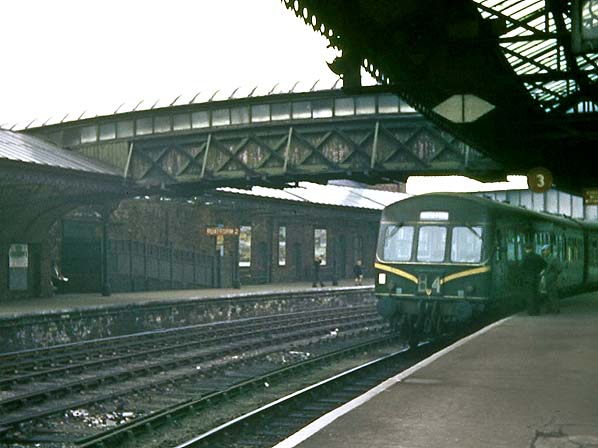
Station Name: BISHOP AUCKLAND
|
| Date opened: | December 1857 |
| Location: | On the west side of Newgate Street |
| Company on opening: | North Eastern Railway |
| Date closed to passengers: | 6.6.1986 |
| Date closed completely: | 6.6.1986 |
| Company on closing: | British Rail (North Eastern Region) |
| Present state: | Demolished - the goodsyard is now a Morrisons and car park. The site of the Durham platform is now a Halfords, a Barclays Bank and part of Morrisons car park |
| County: | Durham |
| OS Grid Ref: | NZ209292 |
| Date of visit: | April 1984 and 7.10.2005 |
|
Notes: The original terminus of the Stockton & Darlington Railway opened at a temporary terminus at South Church on 19.4.1842. Initially trains were steam hauled but the following day this was changed to horse power but as horses were unable to judge their footing in a dark tunnel at Shildon this was once again changed to steam power. Until the opening of the Bishop Auckland Branch to Durham and Leamside a road coach service was run from South Church to Rainton Meadows for through travelers. On 30th January 1843 the line was extended to a permanent Bishop Auckland station. The North Eastern Railway opened a temporary terminus in Tenter Street on 1.4.1857. The Stockton & Darlington and North Eastern stations were replaced by a joint station about December 1857. The station was rebuilt on 2.12.1867 and rebuilt in its final triangular form in 1905. The original station was closed on 6.6.1986 with a new short single platform being built on the site of the Crook platform on the southern side of the triangular station serving trains from Darlington. BRIEF HISTORY OF THE WEAR VALLEY
RAILWAY (this is a shortened version taken from the Weardale
Railway Project web site. Click here
for the full version)
Between Eastgate and Westgate at Cambo Keels, sidings were established to serve the Weardale Iron Company's Heights limestone quarry. This quarry is still operational today. The passenger train service survived until 29th June 1953. Up until closure, four trains per day had served the stations of Witton-Le-Wear, Harperley, Wolsingham, Frosterley, Stanhope, Eastgate, Westgate-in-Weardale, St. Johns Chapel and Wearhead. The freight service to Wearhead survived until 1961 when the line was cut back the St. John's Chapel. West of Eastgate followed in 1968, which is the present terminus. Eastgate cement works were established in 1964 and brought new life to the Wear valley line. Utilising purpose built container wagons, cement was transported mainly by rail from the plant to Teesside, Tyneside and Scotland. This operation ceased on 17th March 1993. The line which existed until 2004 was single throughout between Eastgate and Shildon. There is a connecting spur into Bishop Auckland station - the terminus of the 'Heritage Line' passenger service from Darlington. A summer only Sunday passenger train service to Stanhope operated as an extension to the Darlington service between 1988 & 1992. The success of this service was instrumental in reopening the station at Etherley (renamed Witton Park), in August 1991. A campaign to save the line west of Bishop Auckland, now known as the Weardale Railway, began in 1993 with the threat of closure and track uplift a real possibility after the last cement train ran. Until 2004, the line was mothballed, but purchase by Weardale Railways Limited has now been achieved and the first works trains began running in 2004 in preparation for the reopening of the first section between Stanhope and Wolsingham in July 2004. In February 2005 Weardale Railways Ltd, the company operating the line ran into financial difficulties and it was necessary to call in an administrator. No service operated during 2005 but the Weardale Railway Project are hopeful of of a satisfactory outcome in the near future with a resumption of services some time in 2006. See The Weardale Railway Project web site Click here for Roy Lambeth's memories of the Wear Valley line in the late 1950's & 1960's To see the other stations on the Wear Valley Railway click on the station name: Etherley, Wear Valley Junction, Witton-le-Wear, Harperley, Wolsingham, Frosterley, Stanhope (1st), Stanhope (2nd), Eastgate, Westgate-in-Weardale, St. John's Chapel & Wearhead |
CLICK HERE FOR THE DURHAM
LINE



10.jpg)
Photo by Roy Lambeth

Photo by Roy Lambeth

|
 Home Page
Home Page | Last updated: Friday, 25-Oct-2019 00:45:35 CEST |
© 1998-2005 Disused Stations
|
old1.jpg)














